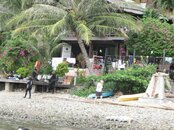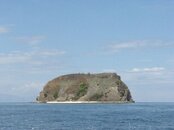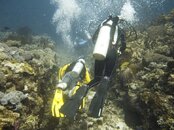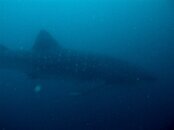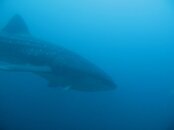bobshreve
Registered
To the members residing in the Philippines, I apologize for all the info you already know. Also, there are some pictures, but I haven't figured out how to get them up.
The Trip
My wife and I went diving last weekend at Anilao, in the Philippines. We live in Makati City and we drove down to Batangas, at the southern end of the main island, Luzon. The 85 mile drive to the Planet Dive Resort on the Anilao peninsula took 2.5 hours. Anilao is the diving area of choice for people in the Metro Manila region (12 million + within the province boundaries, 22 million including the bedroom communities and workshops). This large population allows for higher prices than other areas of the Philippines.
The road goes through some rural areas and there are some wonderful vistas. The vegetation includes a lot of coconut palms, mango trees, and banana plants. There are many wild flowers and flowering trees at this time of the year. We pass between Mt. Makiling, a dormant volcano, and Lake Taal which has an active volcano in it.
The Anilao peninsula is across the Isla Verde Passage from another well known diving area, Puerto Galera on Mindoro Island, and shares the same sorts of sea life. It differs in having generally smaller currents and fewer pelagics. A UN study says that the Philippines is the epicenter of eco-diversity in SE Asia (the coral triangle) and locals say that Anilao and Puerto Galera are the epicenter of Philippine eco-diversity. There are many hard and soft corals as well as sea fans, worms, sponges. As for fish, almost any tropical fish you can think of is there.
The Resort
There are many small marine reserve areas around Anilao with lots of reef fish and there must be fifteen resorts along the peninsula. Towards the end of the peninsula is Planet Dive. The driveway drops off to the right of the road, down toward the sea. After we park, employees carry our equipment bags down the steep steps to the resort which is built on the side of the hill. Our room is very nice with a tiled floor and large windows that look out over a peaked roof to the ocean. We can see Maricaban Island and our sister peninsula across Balayan Bay. Our room is new; I saw it being built the first time I was here, about 6 months ago. It has air conditioning (called aircon here in the islands), and is just above the food preparation and dining area - though you can't tell. The food is good, but not fancy. The room is nice and the aircon keeps it cool enough for us. Our Filipino friends have the room next door: identical except no aircon. They open the windows and the sea breeze keeps it cool enough for them.
The Dives
The dive boats have been run up onto the pebbly beach in front of the resort. They are called bancas and are 25+ feet long with a high sharp prow and a high rounded stern, powered by diesel engines. Our first dive was Beatrice. It is about 15 minutes from the resort. (Several good dive sites are within 5 minutes of the resort).
We headed out toward Sombrero, a sea mount that sticks up 50 feet above sea level. It is maybe an acre in size, with sheer cliffs on all sides. Beatrice Rock is a submerged sea mount a half mile away. There were 8 of us on the boat, 6 divers plus the boatman and his helper. We could see the bottom 50 feet below us. The current looked ok, maybe 2 knots, so we backrolled into the water and dropped down to the top of the mount. Visibility was over 100 feet as it often is here. There are innumerable little coral gardens at the top of the mount, but we swim to a crack in the rock, an underwater ravine, that lies below the current and follow that to the wall of the seamount. We went down to about 100 feet and couldnt see a bottom, so it must have been over 200 feet deep there. When we first went over the edge to the wall, we saw a huge barracuda, around 3 feet long, and later we saw some Jacks (Trevallys). We saw a variety of reef fish, including a couple of lionfish which are common here, and several eels. There were corals, soft corals, and sea anemones, as well as the occasional Gorgonian on the wall. It was a good dive.
We did 3 more dives that day, at Bahura, Mainit Point, and a night dive at Cathedral. The next day we dove on a different side of Bahura and at Herbies Rock. The dives varied from bottomless wall dives and wall dives with sand bottoms to sandy bottoms with 30 foot rocks sticking out. The sessile sea life varied from coral gardens of hard and soft corals to current-swept 4 foot diameter sea fans. As for moving life, we saw all the normal tropical fish, angelfish, butterfly fish, surgeon fish, puffers, trigger fish, and moray eels. One of the great things about the Philippines is that there are lots of different species. We probably saw 6 different species of triggerfish, for example. I dont think we went any deeper than 120 feet and mostly we were between about 50 feet and 90 feet. The water was around 85 F. The currents were variable and could be minimal when we entered, but strong when we came back up. There were trailing ropes and ropes tied to the outriggers to hang onto as you waited to enter the boat.
There were soft coral gardens where all the stalks, all the individual polyps were various shades of pink and lavender. All the polyps were opening and closing their 8 fingered hands rhythmically. There were sea fans that were 4 feet and more in diameter, colored plum and orange and red, sea squirts that were yellow and orange and green. At one point, as we cruised over a flat area of corals with sandy areas between, we noticed a couple of ribbon eels. We stopped to watch one that was much further out of his hole than I had ever seen before. He was being enticed out by a toothsome damselfish. He was probably sticking 14 inches out of his hole. Eventually he noticed us and pulled back to his usual 3 or 4 inch extension.
The most striking fish we saw were a couple of Oriental Sweetlips, about 12 inches long. Our DM held up a shell and made stabbing motions. It was an Ivory Conus, a shellfish that stabs fish (or careless handlers) with a poisonous barb. We also saw some cowries for the first time; a Tiger Cowry and an Egg Cowry. The night dive was great. I had a new light, a UK SL4, and it worked well for me. I saw a large, 2.5 foot, Many-Spotted Sweetlip under a ledge and a local delicacy, a Slipper Lobster, slipping into a hole in the coral. It looked like an armored car with thick armored legs.
On the final dive, the DM began banging his tank. First, I checked my air, then I found him not too far away, and finally, began looking around for a big fish. There was a big one. It must have been 5 meters long. It seemed longer. I had never seen one, but there was no mistaking the side view of a whale shark. It was paralleling the reef wall and moving fast. I finned as close as I could, and looked at the tail which seemed to be barely moving, but it slid past me like a small motorized submersible. The tail seemed about 8 feet tall by itself. What an incredible experience.
Prices for diving are much lower in the Philippines than in the US. For 10 dives between us, 8 meals, and one nights lodging for two, the price was about $300 (13,000 pesos), or $30 per dive. In Hawaii, we paid around $60 a dive with no lodging.
While we were diving at the resort, some Filipinos from Mindanao, called Badjao, came by on a small houseboat or vinta. They are sometimes called sea gypsies and sail from island to island trading. Badjao are also pearl divers, and they had pearls to trade. It was an enjoyable two days away from the city and in the water.
Bob
The Trip
My wife and I went diving last weekend at Anilao, in the Philippines. We live in Makati City and we drove down to Batangas, at the southern end of the main island, Luzon. The 85 mile drive to the Planet Dive Resort on the Anilao peninsula took 2.5 hours. Anilao is the diving area of choice for people in the Metro Manila region (12 million + within the province boundaries, 22 million including the bedroom communities and workshops). This large population allows for higher prices than other areas of the Philippines.
The road goes through some rural areas and there are some wonderful vistas. The vegetation includes a lot of coconut palms, mango trees, and banana plants. There are many wild flowers and flowering trees at this time of the year. We pass between Mt. Makiling, a dormant volcano, and Lake Taal which has an active volcano in it.
The Anilao peninsula is across the Isla Verde Passage from another well known diving area, Puerto Galera on Mindoro Island, and shares the same sorts of sea life. It differs in having generally smaller currents and fewer pelagics. A UN study says that the Philippines is the epicenter of eco-diversity in SE Asia (the coral triangle) and locals say that Anilao and Puerto Galera are the epicenter of Philippine eco-diversity. There are many hard and soft corals as well as sea fans, worms, sponges. As for fish, almost any tropical fish you can think of is there.
The Resort
There are many small marine reserve areas around Anilao with lots of reef fish and there must be fifteen resorts along the peninsula. Towards the end of the peninsula is Planet Dive. The driveway drops off to the right of the road, down toward the sea. After we park, employees carry our equipment bags down the steep steps to the resort which is built on the side of the hill. Our room is very nice with a tiled floor and large windows that look out over a peaked roof to the ocean. We can see Maricaban Island and our sister peninsula across Balayan Bay. Our room is new; I saw it being built the first time I was here, about 6 months ago. It has air conditioning (called aircon here in the islands), and is just above the food preparation and dining area - though you can't tell. The food is good, but not fancy. The room is nice and the aircon keeps it cool enough for us. Our Filipino friends have the room next door: identical except no aircon. They open the windows and the sea breeze keeps it cool enough for them.
The Dives
The dive boats have been run up onto the pebbly beach in front of the resort. They are called bancas and are 25+ feet long with a high sharp prow and a high rounded stern, powered by diesel engines. Our first dive was Beatrice. It is about 15 minutes from the resort. (Several good dive sites are within 5 minutes of the resort).
We headed out toward Sombrero, a sea mount that sticks up 50 feet above sea level. It is maybe an acre in size, with sheer cliffs on all sides. Beatrice Rock is a submerged sea mount a half mile away. There were 8 of us on the boat, 6 divers plus the boatman and his helper. We could see the bottom 50 feet below us. The current looked ok, maybe 2 knots, so we backrolled into the water and dropped down to the top of the mount. Visibility was over 100 feet as it often is here. There are innumerable little coral gardens at the top of the mount, but we swim to a crack in the rock, an underwater ravine, that lies below the current and follow that to the wall of the seamount. We went down to about 100 feet and couldnt see a bottom, so it must have been over 200 feet deep there. When we first went over the edge to the wall, we saw a huge barracuda, around 3 feet long, and later we saw some Jacks (Trevallys). We saw a variety of reef fish, including a couple of lionfish which are common here, and several eels. There were corals, soft corals, and sea anemones, as well as the occasional Gorgonian on the wall. It was a good dive.
We did 3 more dives that day, at Bahura, Mainit Point, and a night dive at Cathedral. The next day we dove on a different side of Bahura and at Herbies Rock. The dives varied from bottomless wall dives and wall dives with sand bottoms to sandy bottoms with 30 foot rocks sticking out. The sessile sea life varied from coral gardens of hard and soft corals to current-swept 4 foot diameter sea fans. As for moving life, we saw all the normal tropical fish, angelfish, butterfly fish, surgeon fish, puffers, trigger fish, and moray eels. One of the great things about the Philippines is that there are lots of different species. We probably saw 6 different species of triggerfish, for example. I dont think we went any deeper than 120 feet and mostly we were between about 50 feet and 90 feet. The water was around 85 F. The currents were variable and could be minimal when we entered, but strong when we came back up. There were trailing ropes and ropes tied to the outriggers to hang onto as you waited to enter the boat.
There were soft coral gardens where all the stalks, all the individual polyps were various shades of pink and lavender. All the polyps were opening and closing their 8 fingered hands rhythmically. There were sea fans that were 4 feet and more in diameter, colored plum and orange and red, sea squirts that were yellow and orange and green. At one point, as we cruised over a flat area of corals with sandy areas between, we noticed a couple of ribbon eels. We stopped to watch one that was much further out of his hole than I had ever seen before. He was being enticed out by a toothsome damselfish. He was probably sticking 14 inches out of his hole. Eventually he noticed us and pulled back to his usual 3 or 4 inch extension.
The most striking fish we saw were a couple of Oriental Sweetlips, about 12 inches long. Our DM held up a shell and made stabbing motions. It was an Ivory Conus, a shellfish that stabs fish (or careless handlers) with a poisonous barb. We also saw some cowries for the first time; a Tiger Cowry and an Egg Cowry. The night dive was great. I had a new light, a UK SL4, and it worked well for me. I saw a large, 2.5 foot, Many-Spotted Sweetlip under a ledge and a local delicacy, a Slipper Lobster, slipping into a hole in the coral. It looked like an armored car with thick armored legs.
On the final dive, the DM began banging his tank. First, I checked my air, then I found him not too far away, and finally, began looking around for a big fish. There was a big one. It must have been 5 meters long. It seemed longer. I had never seen one, but there was no mistaking the side view of a whale shark. It was paralleling the reef wall and moving fast. I finned as close as I could, and looked at the tail which seemed to be barely moving, but it slid past me like a small motorized submersible. The tail seemed about 8 feet tall by itself. What an incredible experience.
Prices for diving are much lower in the Philippines than in the US. For 10 dives between us, 8 meals, and one nights lodging for two, the price was about $300 (13,000 pesos), or $30 per dive. In Hawaii, we paid around $60 a dive with no lodging.
While we were diving at the resort, some Filipinos from Mindanao, called Badjao, came by on a small houseboat or vinta. They are sometimes called sea gypsies and sail from island to island trading. Badjao are also pearl divers, and they had pearls to trade. It was an enjoyable two days away from the city and in the water.
Bob





